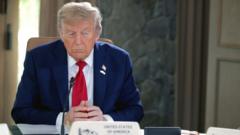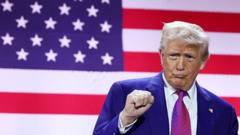During the G7 summit in Alberta, Prime Minister Mark Carney utilized a blend of flattery and firm guidance to secure President Trump's attention on significant issues, averting potential disruptions caused by the American leader's tendency for controversy.
Balancing Act: Managing Trump at the G7 Summit

Balancing Act: Managing Trump at the G7 Summit
Canadian Prime Minister Mark Carney navigates diplomatic waters with President Trump at the G7 summit in Alberta, striving to maintain focus amid global tensions.
Canadian Prime Minister Mark Carney faced a challenging task on the opening day of the G7 summit in Alberta, balancing flattery and discipline to manage his guest, U.S. President Donald Trump. In a strategic departure from their previous Oval Office meeting, where Carney had sought to massage Trump's ego, this time he also needed to curb the president’s more provocative tendencies.
Starting the summit with birthday wishes for Trump, Carney stressed the crucial role of the U.S. in the G7 alliance. However, after just seven minutes of questions where Trump criticized the absence of Russia and lambasted Democrats on immigration, Carney seized the moment to intervene. He stepped forward, capturing the attention of the room and effectively halting the press conference by stating, “If you don’t mind, I’m going to exercise my role, if you will, as G7 chair... we actually have to start the meeting.”
With major issues looming, including violent conflicts in the Middle East and problematic U.S. tariffs affecting the Canadian economy and global trade, Carney’s approach was clear: he was committed to steering the summit towards essential discussions, minimizing distractions attributable to Trump.
This incident encapsulates the broader challenge faced by world leaders when engaging with the unpredictable Trump. The balancing act between managing his requests and maintaining focus on pressing global matters remains a delicate endeavor.





















